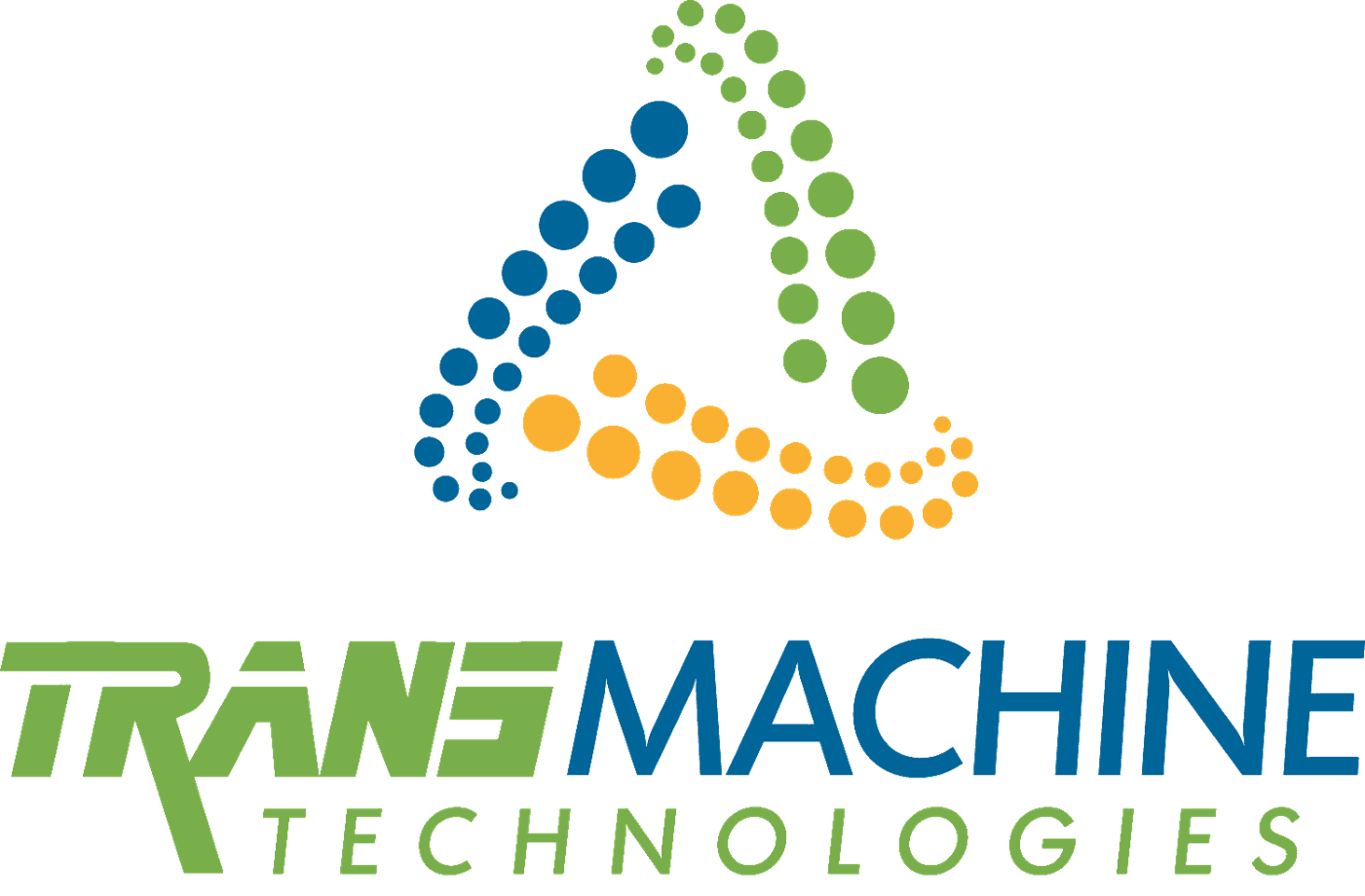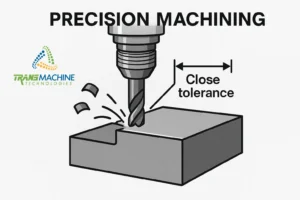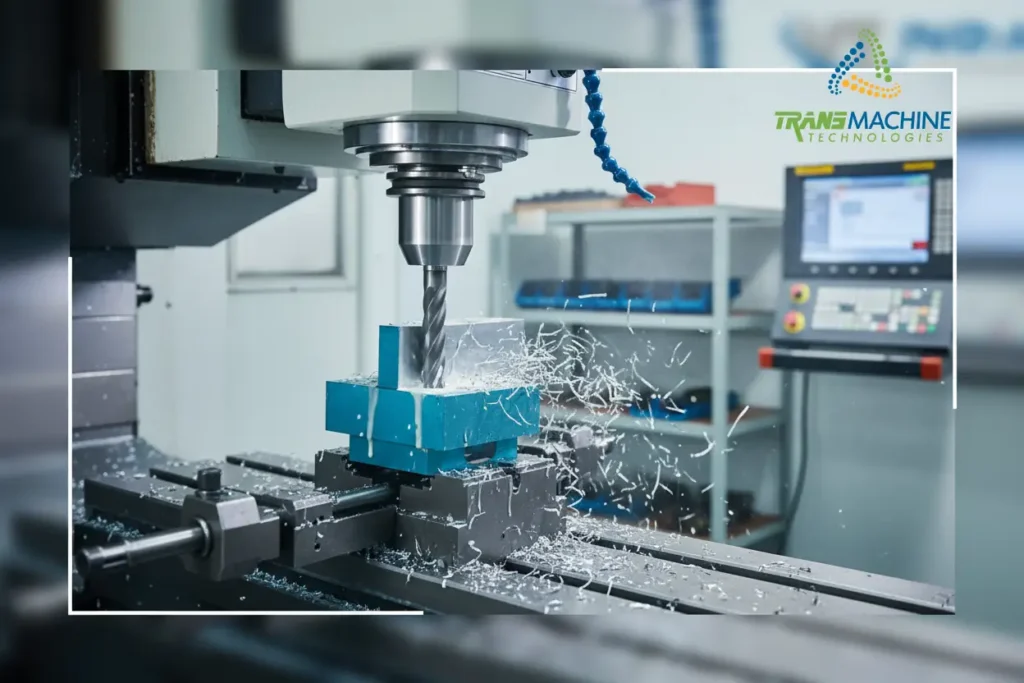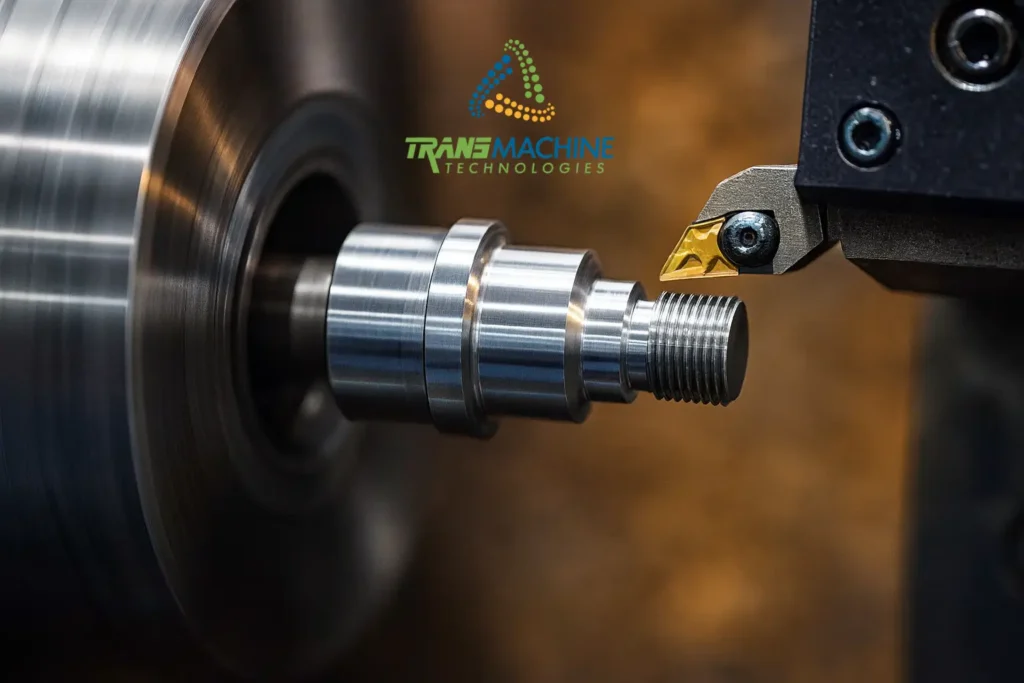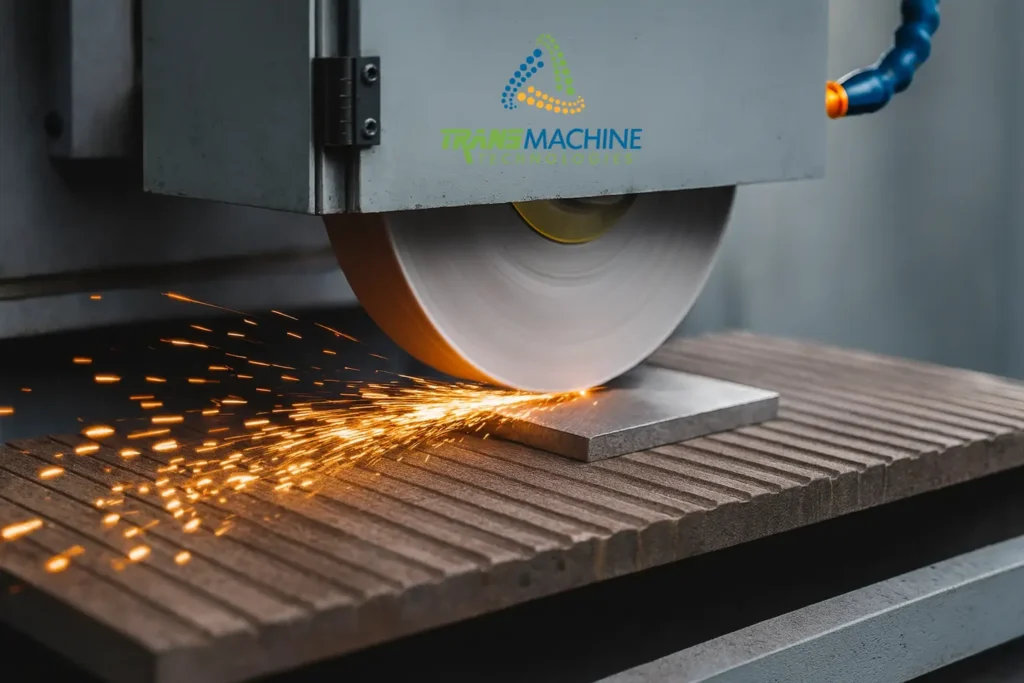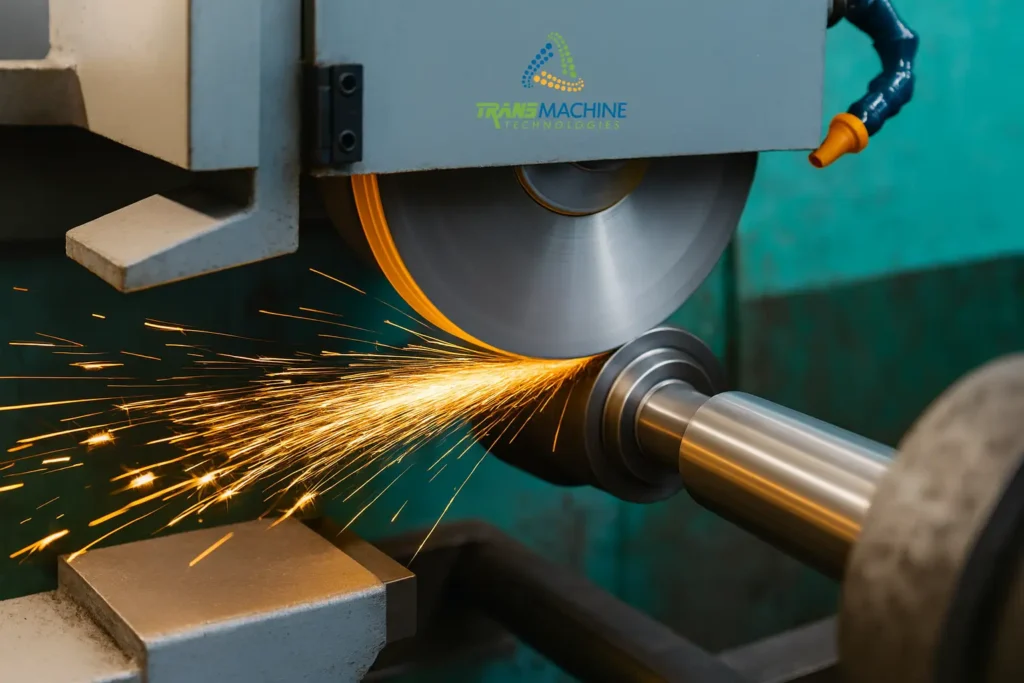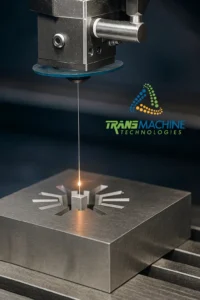With the evolution of Computer Numerical Control (CNC), precision machining has transformed from manual work into a data-driven, automated process. It ensures consistent quality, superior surface finishes, and reliable repeatability
1. What is precision machining?
Precision machining is the process of removing material from a workpiece with extremely tight tolerances and high accuracy. It is essential in industries such as aerospace, automotive, medical devices, and electronics—where even a micrometer-level error can lead to system failure.
It’s the backbone of modern manufacturing, enabling companies to produce world-class components, from jet turbine blades to delicate surgical tools.
2. The Evolution of Precision Machining
Before the advent of precision machining, most manufacturing processes relied heavily on manual labor and conventional tools. Over time, the need for tighter tolerances, improved consistency, and faster production speeds led to the development of more advanced methods.
Precision machining evolved as a response to these demands, leveraging technology to perform tasks that are beyond the capabilities of manual processes. Today, it is at the heart of advanced manufacturing, enabling companies to create components that meet strict specifications and quality standards.
Its evolution can be traced through:
- Traditional Machining: Basic lathes and mills with manual controls
- Semi-Automated Systems: Machines with limited automation features
- CNC Revolution: Full digital control using G-code and CAD/CAM integration
- Smart Manufacturing: Real-time monitoring, predictive maintenance, AI-assisted toolpath optimization
3. Benefits of Precision Machining
Improved Accuracy and Consistency
Precision machining delivers components with micrometer-level tolerances. This level of accuracy ensures each part fits perfectly within a larger assembly, reducing the need for adjustments or rework.
Benefits:
- Enhanced product reliability
- Greater interchangeability of parts
- Higher overall quality control
For industries like aerospace, where failure is not an option, precision is more than a luxury—it’s a necessity. Inaccuracies in even a single component could lead to catastrophic results.
Enhanced Production Speed
Automation via CNC milling allows for faster production cycles. Once programmed, machines can operate 24/7 with minimal supervision. Speed and reliability are critical in reducing lead times and meeting tight project deadlines.
Benefits:
- Quicker time-to-market
- Streamlined manufacturing processes
- Scalability for high-volume production
Reduced Material Waste
Precision machining maximizes material usage by minimizing errors and reducing excess cuts. This contributes to sustainable manufacturing. When parts are made correctly the first time, there’s less need for corrections or complete do-overs.
Benefits:
- Lower raw material costs
- Eco-friendly operations
- Efficient resource utilization
Additionally, less waste means lower environmental impact, aligning your business with green manufacturing goals that are becoming more important to both regulators and consumers.
Lower Production Costs
Though initial setup costs may be higher, the long-term savings are substantial. Reduced waste, fewer defects, and faster turnaround times translate into significant cost efficiencies.
Benefits:
- Higher ROI
- Less dependency on manual labor
- Lower rework and scrap rates
When calculating the total cost of ownership, precision machining often outperforms cheaper, less accurate methods due to its consistency and longevity.
Increased Customization Options
With advanced software and CNC machines, manufacturers can easily customize parts for unique applications or client specifications without extensive retooling.
Benefits:
- Design flexibility
- Rapid prototyping
- Tailored production for niche markets
This flexibility is particularly valuable in industries with rapidly evolving demands or low-volume, high-complexity product lines.
4. Common Types of CNC Machining Processes
CNC machining comprises various techniques, each suited to specific shapes, tolerances, and material types. Understanding these methods helps manufacturers select the most effective approach for each project.
4.1. CNC Milling
CNC milling uses a rotating multi-axis cutting tool to remove material layer by layer. It allows for complex contours, pockets, and precision flat surfaces. With advanced control over tool paths and spindle speeds, CNC milling delivers both accuracy and flexibility for parts with intricate geometries.
Applications: mold bases, housings, brackets, mechanical components.
Advantages:
- High precision and repeatability.
- Suitable for complex 3D geometries.
- Supports a wide range of materials.
Disadvantage:
- Not ideal for very deep or narrow features.
4.2. CNC Turning
In CNC turning, the workpiece rotates while a stationary cutting tool shapes it. This process is ideal for cylindrical or conical parts, offering excellent concentricity and smooth surface finishes. CNC lathes can produce threads, grooves, and tapers with remarkable precision.
Applications: shafts, bushings, threaded parts, pins.
Advantages:
- Produces perfectly round parts with tight tolerances.
- Fast and cost-effective for cylindrical shapes.
- Excellent surface finish.
Disadvantage:
- Limited to rotationally symmetrical parts.
- Complex shapes may require secondary operations.
4.3. Surface Grinding
Surface grinding uses an abrasive wheel to remove small amounts of material and achieve ultra-flat surfaces with tight dimensional accuracy. It is essential when components require excellent surface finish or strict parallelism.
Applications: gauge blocks, mold plates, precision tools.
Advantages:
- Produces mirror-like surface finish.
- Ensures exceptional flatness and dimensional control.
Disadvantage:
- Material removal rate is slow.
- Not suitable for large or irregular shapes.
4.4. Cylindrical Grinding
Cylindrical grinding is used to refine external or internal cylindrical surfaces. It ensures perfect roundness, dimensional accuracy, and superior surface finish for rotating components.
Applications: shafts, rollers, hydraulic and pneumatic parts.
Advantages:
- Achieves high roundness and dimensional precision.
- Produces smooth, consistent surfaces.
Disadvantage:
- Time-consuming setup and process.
- Limited to cylindrical geometries.
4.5. Wire-Cut EDM
Wire-Cut Electrical Discharge Machining uses a thin wire electrode to cut conductive materials by controlled electrical sparks. It can achieve complex shapes, sharp internal corners, and extremely tight tolerances that are impossible with traditional cutting tools.
Applications: die inserts, punches, extrusion molds, precision tooling.
Advantages:
- Cuts extremely hard materials.
- Maintains tight tolerances and clean edges.
Disadvantage:
- Slower than conventional machining.
- Only applicable to electrically conductive materials.
Each CNC machining method offers unique advantages. Milling and turning create shapes efficiently, grinding delivers superior finishes, and EDM handles intricate details or hardened materials. By combining these techniques, manufacturers can produce components that meet the highest precision and performance standards.
5-The Strategic Advantages of Modern CNC Machining
CNC machining as a whole supports the broader goals of precision manufacturing by:
- Achieving uniform tolerances across large production runs
- Automating production to reduce labor errors
- Offering multi-functional capabilities from design to finish
Moreover, CNC systems allow easy adjustments in production for new designs or prototyping. This reduces lead time and provides significant flexibility for customized orders.
With cloud-integrated platforms and real-time sensors, today’s CNC machines are more intelligent than ever. They can track performance metrics, predict tool wear, and even notify operators when intervention is needed—all in real-time.
Advanced CNC systems also support:
- Predictive maintenance for minimizing downtime
- Integration with ERP and MES systems for better operational control
- Real-time performance monitoring
- Digital twins for simulation and optimization
These features position CNC machining as a foundation for Industry 4.0 and smart manufacturing environments. Businesses that embrace this evolution are better equipped to scale, adapt to market changes, and achieve sustainable growth.
6- Process of precision machining
Understanding how a precision-machined component comes to life can give manufacturers, engineers, and procurement teams clearer visibility into quality assurance and production planning. Here’s a streamlined view of the full process:
i. Concept and Digital Design (CAD) Every component starts as a 3D digital model, designed using CAD (Computer-Aided Design) software. At this stage, engineers define dimensions, tolerances, geometries, and even surface finishes. Thoughtful design not only influences part performance but also impacts the cost and ease of machining.
ii. Toolpath Programming (CAM) After design approval, the CAD file is converted into a set of machine-readable instructions using CAM (Computer-Aided Manufacturing) software. The output includes toolpaths, feeds, spindle speeds, and tool selection—optimized for the specific machine and material.
iii. Material Selection and Setup Next, machinists select the proper material block (e.g., aluminum, stainless steel, titanium, PEEK). The raw stock is securely clamped into the CNC machine. Proper fixturing is crucial to prevent movement during machining.
iv. CNC Machining Operations The CNC machine executes the programmed operations, removing material through milling, turning, drilling, or other methods. Multi-axis machines enable complex geometries to be produced in fewer setups, enhancing both efficiency and accuracy.
v. Post-Processing & Surface Finishing Depending on end-use requirements, parts may undergo deburring, bead blasting, anodizing, or polishing. These steps enhance appearance, protect surfaces, or meet industry-specific regulations.
vi. Quality Inspection and Testing The final components are verified against original specifications using tools like CMMs (Coordinate Measuring Machines), micrometers, and visual inspections. For critical industries like aerospace or medical, inspection reports may be required.
vii. Packaging and Delivery Once approved, the parts are carefully packaged to prevent damage in transit and then shipped to the customer—ready for assembly or final integration.
This structured process ensures precision machining isn’t just about cutting metal—it’s a well-orchestrated flow of engineering, automation, quality control, and customer service.
7.Conclusion
Precision machining is an indispensable technology for modern manufacturers seeking to enhance efficiency, reduce costs, and produce high-quality parts. Its integration with CNC milling and alignment with precision engineering practices make it a cornerstone of competitive production environments.
When leveraged correctly, precision machining is more than a method—it’s a strategic asset. It empowers your production line to operate with surgical precision, boosting not only output but also your brand’s reputation for quality and reliability.
Whether you’re scaling up a manufacturing business or entering new markets that demand flawless execution, adopting precision machining practices ensures you’re prepared for future growth.
🚀 Looking for high-quality precision machining services?
Trans Machine Technologies is your trusted partner in delivering exceptional CNC milling and metal fabrication solutions. With state-of-the-art equipment and expert engineers, we ensure your components meet the highest standards. >>>> Our capabilities
👉 Contact Trans Machine Technologies today and take your production efficiency to the next level!
